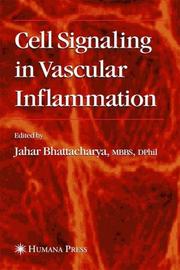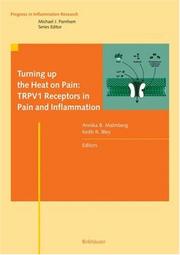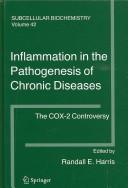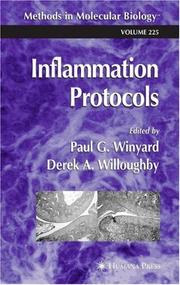| Listing 1 - 10 of 25 | << page >> |
Sort by
|
Book
Year: 2020 Publisher: Washington, DC : United States Institute of Peace,
Abstract | Keywords | Export | Availability | Bookmark
 Loading...
Loading...Choose an application
- Reference Manager
- EndNote
- RefWorks (Direct export to RefWorks)
Periodical
ISSN: 1179139X Year: 2009 Publisher: [Auckland, N.Z.] : Dove Medical Press,
Abstract | Keywords | Export | Availability | Bookmark
 Loading...
Loading...Choose an application
- Reference Manager
- EndNote
- RefWorks (Direct export to RefWorks)
Interferon --- Cytokines --- Interférons --- Periodicals --- Périodiques --- Inflammation --- Interferons. --- Cytokines. --- Inflammation Mediators. --- Interferon. --- Mediators --- Mediators. --- Interferons --- Inflammatory mediators --- Mediators of inflammation --- Mediators of Inflammation --- Mediators, Inflammation --- Inflammatory process --- Antineoplastic agents --- Antiviral agents --- Glycoproteins --- Lymphokines --- Biomolecules --- Cellular immunity --- Immune response --- Inflammasomes --- Viral Interference --- Pathology --- Anti-inflammatory agents --- Regulation --- interferon --- Microbiology & Immunology --- Cytokine --- Interferó. --- Citocines. --- Inflammation Mediators --- Inflammation (Pathologie) --- Médiateurs
Book
Year: 2015 Publisher: [Washington, D.C.] : [U.S. Government Publishing Office],
Abstract | Keywords | Export | Availability | Bookmark
 Loading...
Loading...Choose an application
- Reference Manager
- EndNote
- RefWorks (Direct export to RefWorks)
Mediation --- Mediators (Persons) --- Dispute resolution (Law) --- Legal status, laws, etc.
Book
Year: 2010 Publisher: Washington, D.C. : [National Mediation Board],
Abstract | Keywords | Export | Availability | Bookmark
 Loading...
Loading...Choose an application
- Reference Manager
- EndNote
- RefWorks (Direct export to RefWorks)
Mediation and conciliation, Industrial --- Mediators (Persons) --- Industrial relations --- United States.
Periodical
Abstract | Keywords | Export | Availability | Bookmark
 Loading...
Loading...Choose an application
- Reference Manager
- EndNote
- RefWorks (Direct export to RefWorks)
Prostaglandins --- Prostaglandins. --- Prostaglandines --- Prostanoids --- Inflammation --- Mediators --- Prostaglandin --- Prostanoid --- prostaglandins. --- periodicals. --- publications --- journals --- yearbooks --- dinoprost --- prostanoids --- eicosanoids --- prostacyclin --- synthetic prostaglandins --- Prostaglandines.

ISBN: 1280359161 9786610359165 1592599095 1588295257 1617376191 Year: 2005 Publisher: Totowa, N.J. : Humana Press,
Abstract | Keywords | Export | Availability | Bookmark
 Loading...
Loading...Choose an application
- Reference Manager
- EndNote
- RefWorks (Direct export to RefWorks)
Although inflammatory disease of the vascular bed of the lung is a major cause of morbidity and mortality in both adult and pediatric age groups, the importance of vascular biology to its understanding, and in developing novel therapeutics, has been overlooked. In Cell Signaling in Vascular Inflammation, leading basic and clinical researchers review the signal transduction mechanisms responsible for lung inflammation, including vascular hyperpermeability, white cell accumulation, and vascular remodeling. The authors cut across disciplines to bring together a broad-based presentation of inflammatory challenge, both in the initial phases of the inflammatory response, as well as in the more prolonged phase of genomic involvement. Authoritative and state-of-the-art, Cell Signaling in Vascular Inflammation offers physiologists, molecular and cell biologists, and pharmaceutical scientists a comprehensive survey of the signal transduction pathways in lung vascular cells that illuminates not only the processes of lung inflammation, but also the potential for developing new therapeutic strategies to combat inflammatory lung disease.
Vasculitis. --- Cellular signal transduction. --- Inflammation --- Mediators. --- Medicine. --- Vascular surgery. --- Medicine & Public Health. --- Vascular Surgery. --- Vascular surgery --- Clinical sciences --- Medical profession --- Human biology --- Life sciences --- Medical sciences --- Pathology --- Physicians --- Inflammatory mediators --- Mediators of inflammation --- Biomolecules --- Cellular information transduction --- Information transduction, Cellular --- Signal transduction, Cellular --- Bioenergetics --- Cellular control mechanisms --- Information theory in biology --- Angiitis --- Blood-vessels --- Vasculitides --- Diseases --- Surgery.

ISBN: 1280413468 9786610413461 3764373792 3764370807 Year: 2005 Publisher: Basel ; Boston : Birkhauser Verlag,
Abstract | Keywords | Export | Availability | Bookmark
 Loading...
Loading...Choose an application
- Reference Manager
- EndNote
- RefWorks (Direct export to RefWorks)
Despite tremendous advances in the understanding of the sensory nervous system which have accompanied the recent explosive growth of the neurosciences, rema- ably few innovative medicines directed towards pain and inflammation are ava- able. Indeed, many patients are still prescribed analgesic and anti-inflammatory medications that were identified long ago as components of herbal remedies. Si- larly, potential new medicines in clinical evaluation based on capsaicin and the c- saicin receptor are both grounded firmly on folk traditions and yet rely upon the most contemporary techniques of drug discovery and delivery. The first formal report of the pain-relieving properties of capsaicin appeared in 1850 [1]. However, for centuries before this, capsaicin-containing extracts had been used as folk medicines in cultures with access to pepper plants, much in the same way as poppy or willow-bark extracts were. Despite widespread use, it was not until 1878 that the selective action of capsaicin on the sensory nervous system was r- ognized [2]. In Chapter 1 of this volume, Janos Szolcsányi reviews this early research, which culminated with the seminal studies of Nicholas Jansco and his c- leagues in Hungary in the 1940s. Since then, capsaicin and related vanilloid c- pounds have played a prominent role in analgesia and inflammation investigations because of their ability to selectively activate a subpopulation of sensory neurons and produce sensations of pain and localized erythema.
Nociceptors. --- Pain. --- Inflammation. --- Inflammation --- Mediators. --- Inflammatory mediators --- Mediators of inflammation --- Biomolecules --- Inflammatory process --- Pathology --- Anti-inflammatory agents --- Aches --- Emotions --- Pleasure --- Senses and sensation --- Symptoms --- Analgesia --- Suffering --- Pain receptors --- Sensory receptors --- Pain Medicine. --- Immunology. --- Neurosciences. --- Toxicology. --- Cytology. --- Pharmacology/Toxicology. --- Cell Biology. --- Cell biology --- Cellular biology --- Biology --- Cells --- Cytologists --- Chemicals --- Medicine --- Pharmacology --- Poisoning --- Poisons --- Neural sciences --- Neurological sciences --- Neuroscience --- Medical sciences --- Nervous system --- Immunobiology --- Life sciences --- Serology --- Toxicology --- Algiatry --- Pain medicine. --- Pharmacology. --- Cell biology. --- Drug effects --- Medical pharmacology --- Chemotherapy --- Drugs --- Pharmacy --- Physiological effect

ISBN: 1280865318 9786610865314 1402056885 1402056877 9048174295 Year: 2007 Publisher: New York : Springer,
Abstract | Keywords | Export | Availability | Bookmark
 Loading...
Loading...Choose an application
- Reference Manager
- EndNote
- RefWorks (Direct export to RefWorks)
Discusses the role of inflammation in the pathogenesis of major chronic diseases and the controversy regarding risk versus benefit of selective cyclooxygenase-2 (COX-2) inhibitors. This volume is intended for scientists in medicine, epidemiology, pharmacology, molecular biology, and related fields.
Cyclooxygenase 2 --- Nonsteroidal anti-inflammatory agents. --- Inflammation --- Inhibitors. --- Mediators. --- Inflammatory mediators --- Mediators of inflammation --- Biomolecules --- Non-steroid anti-inflammatory agents --- Non-steroidal anti-inflammatory agents --- NSAIDs (Pharmacology) --- Anti-inflammatory agents --- Toxicology. --- Oncology. --- Pathology. --- Cardiology. --- Neurology. --- Immunology. --- Pharmacology/Toxicology. --- Cancer Research. --- Immunobiology --- Life sciences --- Serology --- Medicine --- Nervous system --- Neuropsychiatry --- Heart --- Internal medicine --- Disease (Pathology) --- Medical sciences --- Diseases --- Medicine, Preventive --- Tumors --- Chemicals --- Pharmacology --- Poisoning --- Poisons --- Toxicology --- Pharmacology. --- Cancer research. --- Neurology . --- Drug effects --- Medical pharmacology --- Chemotherapy --- Drugs --- Pharmacy --- Cancer research --- Physiological effect
Book
ISBN: 1281876577 9786611876579 3764376503 3764376260 Year: 2008 Publisher: Basel : Birkhäuser Basel : Imprint: Birkhäuser,
Abstract | Keywords | Export | Availability | Bookmark
 Loading...
Loading...Choose an application
- Reference Manager
- EndNote
- RefWorks (Direct export to RefWorks)
Angiogenesis is an essential component of inflammation and its resolution. This volume provides up-to-date information on the latest developments in the pathology, mechanisms and therapy of angiogenesis dependent inflammatory disease. Recent years have seen large advances in angiogenesis research, especially in oncology. Traditionally mechanisms in inflammation angiogenesis were inferred from tumour angiogenesis, however recent research has matured highlighting the similarities and dissimilarities between these processes. This volume relates the lessons learned from tumour biology applied to inflammation. This issue of Angiogenesis in Inflammation: Mechanisms and Clinical Correlates develops current knowledge on the mechanisms at the molecular and cellular levels as they relate to inflammation, including acute and chronic inflammation, neurogenic initiation, and the role of the multiple cellular components that comprise inflammation: granulocytes, macrophages, fibroblasts, dendritic cells and lymphocytes. This is related to inflammatory disease: not only the familiar angiogenesis dependent diseases of rheumatoid arthritis and psoriasis, but also loci such as the lung, gastric ulcers, the eye with uveitis, wound healing and periodontal disease and their therapy, how this knowledge may be used in the discovery of novel therapeutics. The volume brings together experts in each of these fields to link the molecular and cellular processes in angiogenesis to those of inflammation and disease, culminating in a discourse on areas for future therapies.
Neovascularization. --- Inflammation --- Mediators. --- Inflammatory mediators --- Mediators of inflammation --- Biomolecules --- Angiogenesis --- Blood-vessels --- Growth --- Immunology. --- Oncology. --- Internal medicine. --- Angiography. --- Cytology. --- Cancer Research. --- Internal Medicine. --- Angiology. --- Cell Biology. --- Cell biology --- Cellular biology --- Biology --- Cells --- Cytologists --- Diagnosis, Radioscopic --- Radiography, Medical --- Medicine, Internal --- Medicine --- Tumors --- Immunobiology --- Life sciences --- Serology --- Radiography --- Cancer research. --- Cell biology. --- Cancer research --- Cancer. --- Cancer Biology. --- Diseases. --- Angiology --- Vascular diseases --- Cancers --- Carcinoma --- Malignancy (Cancer) --- Malignant tumors

ISBN: 0896039706 9786610842520 1280842520 1592593747 9780896039704 161737282X Year: 2003 Volume: 225 Publisher: Totowa, N.J.: Humana press,
Abstract | Keywords | Export | Availability | Bookmark
 Loading...
Loading...Choose an application
- Reference Manager
- EndNote
- RefWorks (Direct export to RefWorks)
Because inflammation is involved in many chronic human diseases, its proper understanding may provide important clues to new therapeutic targets. In Inflammation Protocols, highly skilled experimenters present key techniques for the multidisciplinary study of inflammation in such conditions as inflammatory bowel disease, rheumatoid arthritis, renal disease, and cardiovascular disease. Described in step-by-step detail to ensure experimental success, the techniques are focused on the research and development of potential new antiinflammatory drugs in active target areas. The protocols are suitable for many current areas of drug discovery research, including transcription factors, cytokines, adhesion molecules, cyclooxygenase-2 (COX-2) inhibitors, free radicals, nitric oxide synthases, complement activation, angiogenesis, wound healing, immune rejection, and metalloproteinases. The methods provide in vitro systems for studying inflammation, in vivo models, and relevant pharmacodynamic measurements for the assessment of antiinflammatory compounds. Each protocol contains notes about potential pitfalls and tips on how to avoid failure. Overview chapters at the start of each section review the significance and potential limitations of the protocols presented. Cutting-edge and highly practical, Inflammation Protocols offers experimental and clinical researchers a premier collection of readily reproducible techniques not only for evaluating inflammatory disease processes, but also for the discovery of new drugs for treating chronic human inflammatory diseases today.
Inflammation --- Anti-inflammatory agents --- Mediators --- Anti-inflammatory agents -- Laboratory manuals. --- Electronic books. -- local. --- Inflammation -- Laboratory manuals. --- Inflammation -- Mediators -- Laboratory manuals. --- Anti-Inflammatory Agents --- Pathologic Processes --- Therapeutic Uses --- Pharmacologic Actions --- Pathological Conditions, Signs and Symptoms --- Diseases --- Chemical Actions and Uses --- Chemicals and Drugs --- Pathology --- Medicine --- Health & Biological Sciences --- Anti-inflammatories --- Antiinflammatory agents --- Antiphlogistics --- Antipyretics --- Inflammatory process --- Immunology. --- Immunobiology --- Life sciences --- Serology --- Inflammation - Laboratory manuals --- Inflammation - Mediators - Laboratory manuals --- Anti-inflammatory agents - Laboratory manuals
| Listing 1 - 10 of 25 | << page >> |
Sort by
|

 Search
Search Feedback
Feedback About UniCat
About UniCat  Help
Help News
News